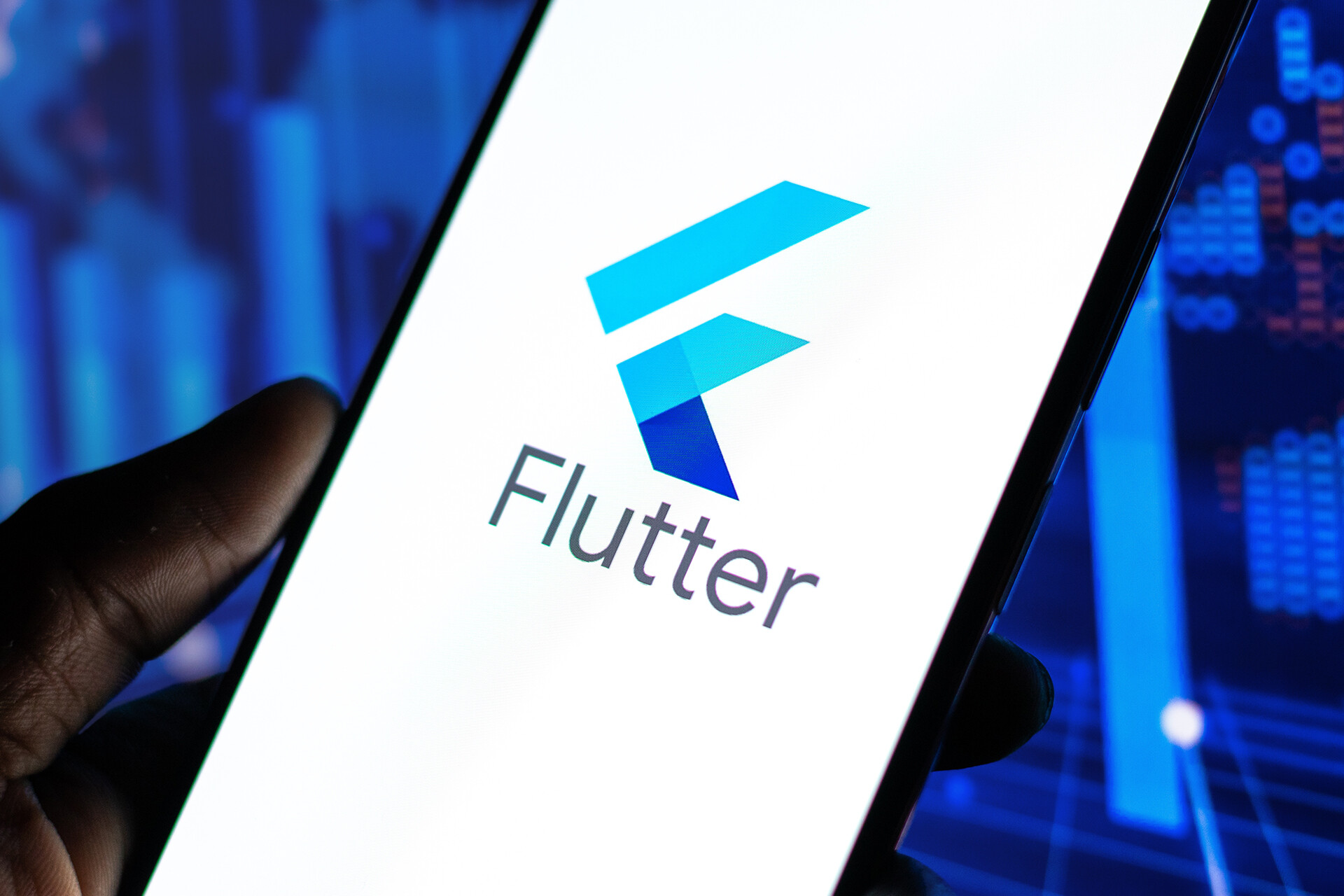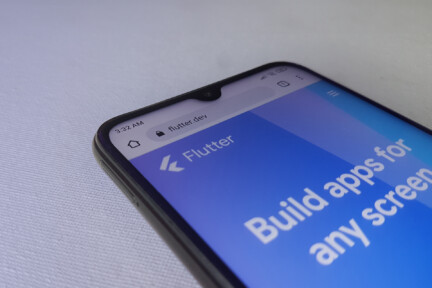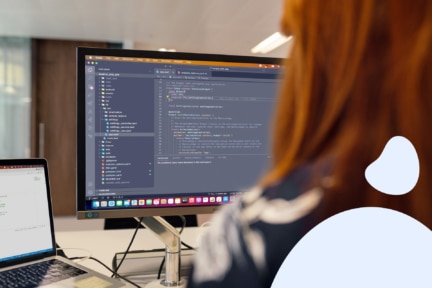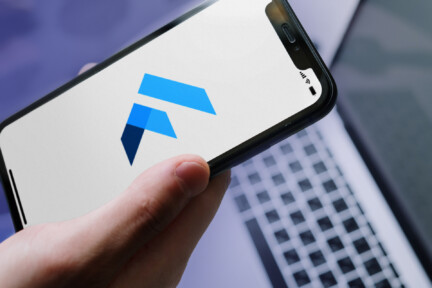There are apps for everything, from entertainment to commerce to education to government services. The proliferation of apps shows that many organizations are leaning towards creating web and mobile applications to connect with over 6.84 billion smartphone users.
So, it’s no longer a question of whether you should develop an app. You definitely should. The question is how you should do it. If you’re reading this, you’ve probably heard of Flutter and how it can help you create applications.
One of the frequent questions people ask is: how much does Flutter app development cost? The short answer is between $15,000 for a simple application and $500,000 for a complex app.
Read on to learn what factors influence Flutter app costs and how it compares to other frameworks. We’ll also share tips on how to minimize costs and guide you in choosing an experienced Flutter development team.
Overview of Flutter
Flutter is an open-source user interface (UI) framework developed by Google. Businesses use it to build and deploy desktop, mobile, and web applications quickly. It uses a single codebase to develop apps for multiple operating systems.
Instead of separate development cycles for iOS and Android apps, you can launch a single app that works across both platforms. That is the fundamental difference between native vs. cross-platform app development, which Flutter supports.
Key Flutter features include:
- Hot Reload: When developers create or update a native app, they must compile and load the code to review the changes. With hot reloading, you see changes to the code in real time without restarting the application.
- Customizable Widgets: Material Design and Cupertino support Flutter’s wide range of widgets. These design languages adapt the appearance of widgets to the appropriate app platform, delivering a consistent user experience to Google Play Store and Apple Store users.
- Open-source community: Developers can integrate third-party software to streamline the app development process.
- Outstanding performance: Flutter’s high performance is due to the Skia rendering engine. It runs 60 frames per second, facilitating visually stunning and responsive user interfaces.
These features work together to reduce the time and cost of app development for brands like Square, eBay, and Google.
Factors Influencing Development Cost
Earlier, we shared a cost range for apps with Flutter development. That was a rough estimate. The final price depends on several factors. Understanding these will help you plan and budget your project appropriately.
1. Complexity of the app
Apps have a low, medium, and high classification based on how complicated they are to develop. Low-complexity Flutter applications have a simple UI and a minimum viable product (MVP) feature set. Medium apps have tools for engagement and monetization. Highly complex apps have advanced features and top-level functionality.
An app with simple features will cost less than one with complex features.
See the side-by-side comparison below.
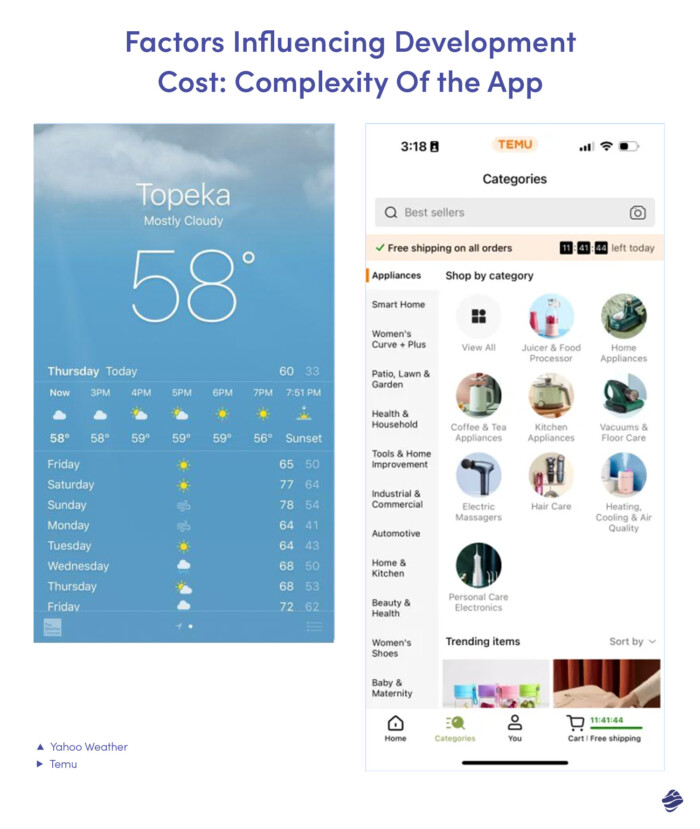
The Weather app, which only displays forecasts, is easier to build than Temu, with hundreds of product pages and payment gateways.
App complexity affects development time and influences the Flutter app development cost. An app that takes a year to develop will accrue more costs than one that takes three months.
2. Features and Functionality
The number and types of features you include impact your Flutter app cost. Adding features contributes to the app’s complexity, leading to a higher Flutter app cost. Moreover, not all features are created equal.
Basic features like login are simple to build and don’t cost much. On the other hand, a chatbot powered by artificial intelligence is pricey because it requires specialized coding skills.
Flutter’s app categories have different features, functions, and requirements. Thus, some app categories cost more than others. For instance, the gaming category offers advanced animation and augmented reality, making it more expensive than the utility category, which doesn’t require these.
3. App Design
An intuitive and visually appealing UI is critical to a positive user experience. But that comes with a higher Flutter app development cost.
The primary design cost culprits are animation content, layout complexity, visual components, and user interaction.
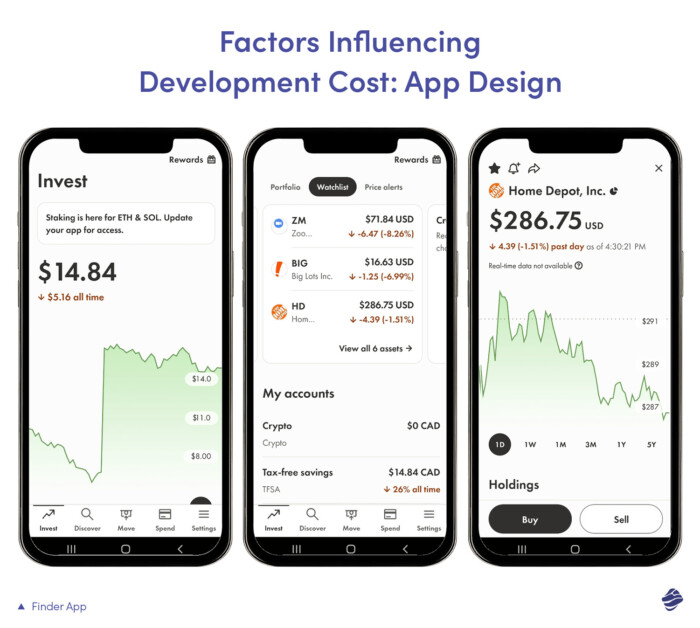
This trading app’s user interface design is easy to navigate and only displays necessary account information.
Compare this to the Minion running game, with bright graphics and dynamic elements.
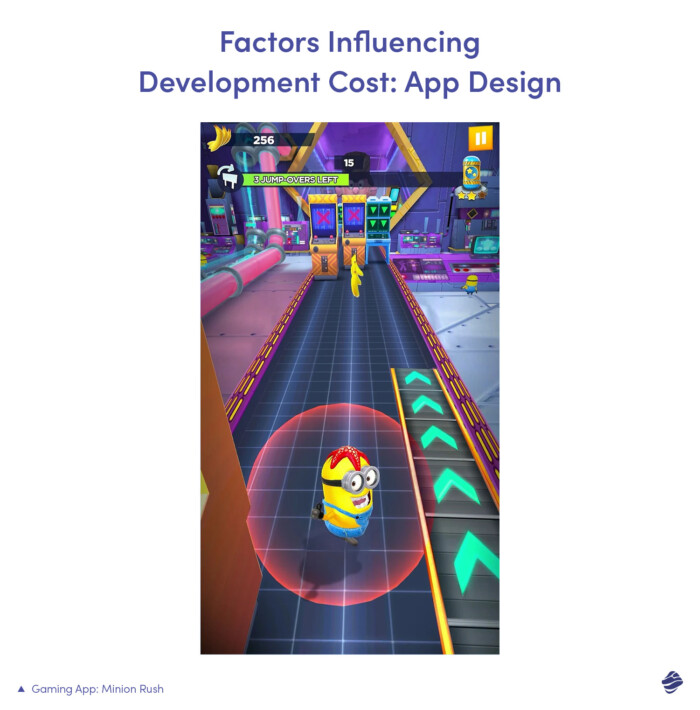
The more sophisticated these design elements are, the more you’ll pay. A gaming app costs more than a fitness tracking app because of the high-definition animation and interactive menus.
4. Integration
Third-party APIs increase the average Flutter app development cost. You not only pay for each new software or hardware; you may also have to pay for an expert who knows their programming languages to ensure your tech stack is aligned.
Examples of third-party integrations include cloud hosting, data storage, payment gateways, and SMS push notifications. Your choice of these technologies will impact your cross-platform development budget.
5. Labor
Labor is your biggest cost center, regardless of whether you outsource to a Flutter app development company like Miquido or create your app in-house. However, the cost will differ depending on which you choose.
In-house development comes with considerable overhead and benefits costs. Outsourcing development doesn’t. You only pay for the hours worked.
Flutter mobile app development cost also varies by location. Generally speaking, North America has the highest developer hourly rates followed by Western Europe.
Flutter Vs React Native: Comparative Cost Analysis
Flutter isn’t the only app development platform out there. But it is the most popular. Even though it was released in 2017, it takes the largest share in the cross-platform app development services market.
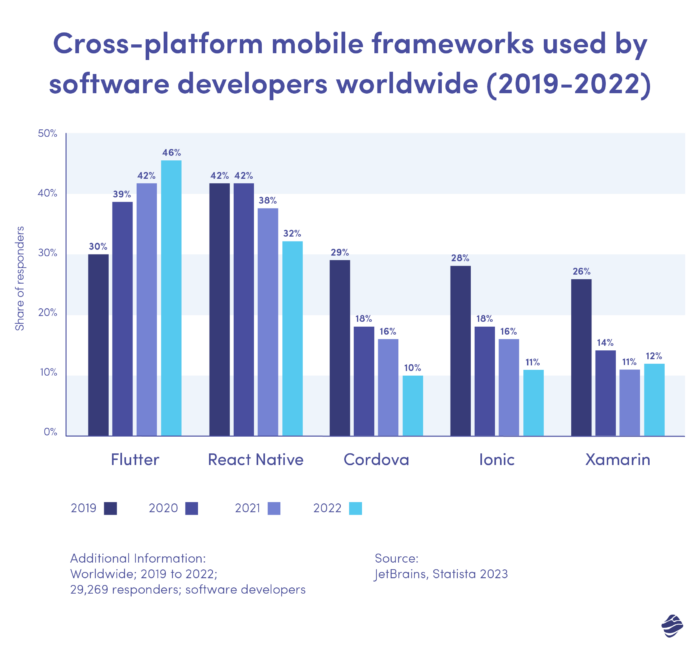
As of 2022, 46% of app developers used Flutter, followed by React Native (32%), Cordova (10%), and Ionic (11%). Xamarin rounds out the top five list at 12%.
Let’s look at the Flutter vs React Native cost comparison.
React Native is an open-source framework developed by Meta. It is Flutter’s closest competitor, with a 32% market share.
Cost and time savings offered by Flutter reflect lower average development costs compared to React Native.
Xamarin is a cross-platform framework from Microsoft. The average cost of development is between $5,000 and $15,000. That is considerably cheaper than Flutter and React Native. However, there is a catch. It requires businesses to pay licensing fees for Visual Studio IDE, which becomes costly at the enterprise level.
Budget Planning for Flutter Projects
Development costs aren’t your only project expense. You must also allocate funds for planning, design, testing, and app maintenance. A study from McKinsey found that 66% of enterprise software projects have cost overruns.
Online calculators like Estimate My App and Cleveroad help users calculate upfront costs. By answering questions about app size, desired features, integrations, and operating system destination, you get a clearer picture of how much you should allocate to your app development budget.
Other tips to ensure your budget is realistic include:
- Define deliverables for a minimum viable product.
Well-defined requirements safeguard against cost overruns. So, flesh out what your app looks like and what it does.
Ask yourself: what are the core features and functions? What infrastructure do I need? What user experience designs should I include? How many security and compliance measures must I consider? The list goes on.
- Use historical data to estimate labor costs.
The best way to create a realistic budget is to study similar past projects. For instance, if you used Flutter for web development, you can see how much time and money that project took. Industry benchmarks can also help you make accurate estimates.
- Create a contingency plan.
Life happens. Your chief Flutter developer quits. Testing takes longer than expected. These scenarios cause costly delays. Therefore, pad your budget by 5 to 30%. That way, you can resolve unforeseen issues and maintain timely project delivery.
Long-Term Cost Benefits
When considering the benefits of Flutter, don’t just look at the upfront expenses. There are also long-term savings and return on investment (ROI).
The primary way Flutter helps maximize ROI is through rapid development speed. It accelerates development time two to three times. A shorter time to market means you’re making money sooner. So, you’re saving money upfront and getting your ROI quicker.
Speedy delivery is also beneficial in the post-development stages. To remain competitive, you must quickly fix bugs, add new features, and update security and compliance. Since Flutter uses a single code, any changes there will deliver updates to your apps on different platforms. It also means you don’t need separate teams to maintain iOS and Android apps.
Another way Flutter maximizes ROI is brand consistency. Using the same code delivers a consistent user experience across all platforms, strengthening brand identity and customer loyalty.
Choosing the Right Flutter Development Team
An effective software development team has the following members:
- Product owner – oversees app creation and serves as the link between the project team and organization.
- Project manager – manages project progression, ensuring timely and on-budget delivery.
- Business analyst – analyzes the project requirements to ensure it meets business goals.
- UI designer – creates user experience, ensuring an attractive and user-friendly app.
- Flutter app developers – build the application.
- Quality Assurance specialists – test the app to ensure it meets project requirements.
You have two options when it comes to building your team. Hire an in-house team or outsource to Flutter app development services.
With the in-house approach, your HR team spearheads recruitment. The advantages of this approach are project control and effective communication and collaboration. The disadvantages are a time-consuming hiring process and retaining top talent gets expensive.
The cost considerations for in-house development include salaries, benefits, office space, hardware, software, and training.
Outsourcing involves partnering with a software development company to deliver and manage your solution. The advantages of this approach are cost-effectiveness and access to experienced developers. The disadvantages are potential loss of oversight and communication challenges.
The cost considerations for outsourced development are agency fees.
Whichever option you choose, check references and portfolios to ensure they have expertise in developing similar apps to the one you want.
Flutter Application Development Pricing Models
No two projects are identical. It makes things easier when development companies offer multiple price structures to fit different clients.
There are three popular pricing models used in software development.
- Time and material: calculates price based on time and resource used.
- Fixed price: stipulates a predetermined cost, regardless of the time and effort used.
- Hybrid: combines the fixed price and time and material models.
Each billing structure has its advantages and disadvantages. The time and material model provides flexibility. However, budget overruns become common occurrences if requirements aren’t well-defined. Fixed price contracts provide budget stability. However, they don’t allow for scope or requirements changes, which may affect app quality.
The hybrid model is the best of both worlds, offering budget predictability and project flexibility. For example, you may have a fixed price for core app development services and use the time and material method for subsequent work.
Cost-Saving Tips and Tricks
Flutter’s cost-saving benefits are impressive, but you can still do more to minimize cost without compromising quality.
- Create a requirements document. Unclear requirements and specifications result in reworks, delays, and additional costs. When you clearly define project requirements, you ensure everyone is on the same page and deliver a quality product.
- Outsource app development. Outsourcing parts or all of your project to agencies or freelancers delivers savings on overhead and labor costs. Furthermore, a dedicated team of mobile app developers reduces time to market and delivers ROI sooner.
- Implement agile methodologies. Agile development breaks projects into manageable phases. It reduces risks associated with managing complex projects, such as scope creep, which results in additional costs and delays.
- Launch with the MVP version of your app. Identify and prioritize the primary features and app functionalities needed to deliver value. Remember, more features increase app complexity, raising the cost of Flutter app development. You can always add features to future development.
If you follow these tips, you can build a quality product in less time, saving you money.
Miquido’s Approach to Cost-Effective Flutter Development
Why struggle to build an app when you can partner with an award-winning software development company like Miquido? You free up in-house staff for operational priorities, accelerate time to market, and minimize delays and budget overruns.
We’ve done this before and delivered impressive Flutter apps, including Voicy, an app to create, discover, and share audio clips.
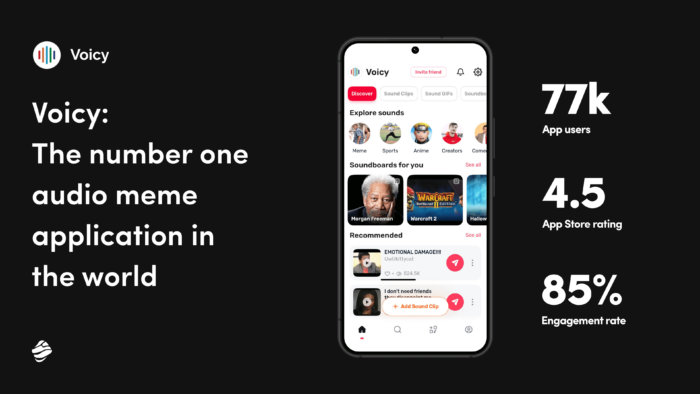
Miquido delivered Android and iOS applications, increasing Voicy’s reach to 77,000 new users. Efficient collaboration between designers and Flutter app developers throughout the development cycle ensured a high-performing product with a 4.6 rating on the Apple App Store and an 85% engagement rate.
Using Flutter, Miquido reduced costs by eliminating the need for separate Android and iOS development teams. We also used Flutter’s pre-built widgets and libraries to speed delivery while offering a consistent user experience.
In Closing: How Much Does Flutter App Development Cost?
Building high-quality apps can be overwhelming, from collecting requirements to choosing qualified teams. It can also be expensive, with money pits at every development stage.
Flutter makes building applications cheap and convenient compared to native app development. Simply using cross-platform development cuts your budget and timeline in half. That said, it’s difficult to put a concrete number to the question – how much does Flutter app development cost?
This guide showed you the underlying factors that affect the final price tag, including app complexity and the development team you hire. Understanding these variables (and how to optimize them) is critical to the success of your Flutter app development project.

